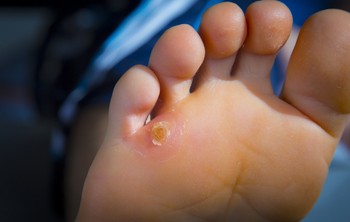
 A corn on the foot is a small area of hardened skin that typically develops as a result of excess friction. They can develop from wearing shoes and socks that do not fit correctly. Soft corns can form between the toes and can remain moist as they rub against the neighboring toes. This type of corn can cause severe pain and can alter the gait to compensate for the discomfort. Hard corns can form on the outside of the pinky toe, or on the sole of the foot. These can develop from standing for the majority of the day, in addition to having aging feet. One potential treatment option is wearing the correct shoes in order to eliminate a portion of the friction on the corn. Corns can be quite painful, and it is suggested that you speak to a podiatrist about how to prevent and treat corns on the feet.
A corn on the foot is a small area of hardened skin that typically develops as a result of excess friction. They can develop from wearing shoes and socks that do not fit correctly. Soft corns can form between the toes and can remain moist as they rub against the neighboring toes. This type of corn can cause severe pain and can alter the gait to compensate for the discomfort. Hard corns can form on the outside of the pinky toe, or on the sole of the foot. These can develop from standing for the majority of the day, in addition to having aging feet. One potential treatment option is wearing the correct shoes in order to eliminate a portion of the friction on the corn. Corns can be quite painful, and it is suggested that you speak to a podiatrist about how to prevent and treat corns on the feet.
If you have any concerns regarding your feet and ankles, contact one of our podiatrists of Achilles Foot Clinic. Our doctors will treat your foot and ankle needs.
Corns: What Are They? and How Do You Get Rid of Them?
Corns can be described as areas of the skin that have thickened to the point of becoming painful or irritating. They are often layers and layers of the skin that have become dry and rough, and are normally smaller than calluses.
Ways to Prevent Corns
There are many ways to get rid of painful corns such as wearing:
Treating Corns
Treatment of corns involves removing the dead skin that has built up in the specific area of the foot. Consult with Our doctors to determine the best treatment option for your case of corns.
If you have any questions, please feel free to contact one our office, located in the South of Calgary, Alberta. We offer the newest diagnostic and treatment technologies for all your foot care needs.